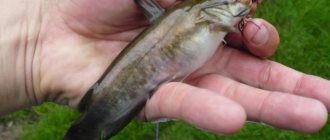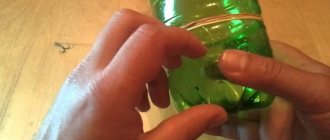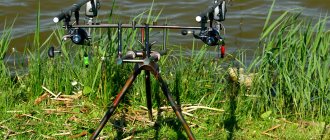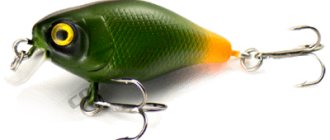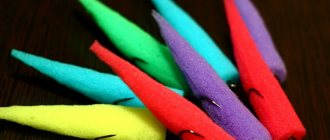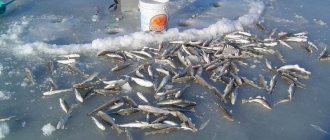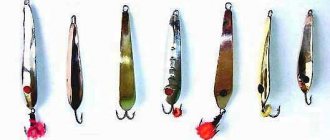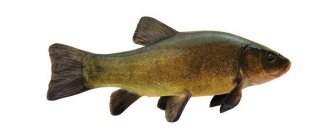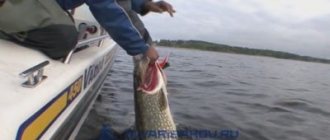What is better for pike perch, a whole fish or its pieces?
Let's try to figure this out. When and what does pike perch bite best? It is worth catching whole dead fish during the warmer months of the year. But when choosing bait for each month, you need to pay attention to its size.
When the water warms up as much as possible, and this happens in July and August, it is worth using the smallest fish. Even with tiny live bait 2-3 cm long you can catch a large pike perch during this period. This is due to the large number and high activity of fry during the hot period.
In September, May and June, the size of the fish should be slightly larger. Small fish with a narrow body up to 10 cm in length are well suited for fishing during this period. With the advent of October, the water temperature drops significantly.
Starting from this period, the predator goes to the depths and saves energy for wintering, hunting only when it is completely confident of an easy profit.
As the water cools, pieces of fish begin to dominate the bait. They emit a more intense odor, attracting the fanged predator.
Posting a rig with a dead fish
Catching pike with dead fish using a tackle takes place in the same places as fishing with artificial bait. And the wiring is actually the same. Stepped - starting from a smooth swing of the rod to the classic step “three turns - three seconds pause”. Pauses can be prolonged “indefinitely,” because a predator can grab the bait even after a pause of 5-8 seconds.
The bites on the tackle are usually quite obvious, while the “toothy” one is in no hurry to spit out the bait, continuing to hold it in its mouth. Therefore, there is always enough time for a quality hook with this method of fishing.
In what layers to catch pike perch?
The time of year affects not only the use of each type of bait, but also the type of water in which to fish. Everyone can experimentally select the depth at which they will fish for pike perch.
But still, proven rules should not be neglected. It is best to lift dead whole fish 20-30 cm from the bottom, and its pieces are best served directly to the bottom.
You need to deviate from such recommendations in the case when there are no bites for a long time.
Installation of equipment for pike perch
The easiest way to fish in still water is with a float tackle. In this case, there are no problems with installing the fish. You just need to measure the depth at the fishing point and fix the float at the required distance.
3 ways to improve your fish bite!
Over 15 years of active fishing, I have found many ways to improve the bite, and here are the most effective:
1. Bite activator . This pheromone additive attracts fish most strongly in cold and warm water. The Fish Hungry bite activator has proven itself to be excellent - Read more…
2. Tackle with increased sensitivity . You should first familiarize yourself with the features of using a particular type.
3. Pheromone baits . They attract the attention of fish, stimulate hunger and cause a schooling reflex, which allows you to collect a lot of fish in one place.
You can get the rest of the secrets of successful fishing for free by reading my other materials on the site.
3 ways to improve your fish bite!
Over 15 years of active fishing, I have found many ways to improve the bite, and here are the most effective:
1. Bite activator . This pheromone additive attracts fish most strongly in cold and warm water. The Fish Hungry bite activator has proven itself to be excellent - Read more…
2. Tackle with increased sensitivity . You should first familiarize yourself with the features of using a particular type.
3. Pheromone baits . They attract the attention of fish, stimulate hunger and cause a schooling reflex, which allows you to collect a lot of fish in one place.
You can get the rest of the secrets of successful fishing for free by reading my other materials on the site.
Thus, the bait will always be supplied at the required distance from the surface of the water. If you are fishing for pike perch in the current, then you cannot do without a heavy weight. There will be no problems with delivering a piece of fish to the bottom.
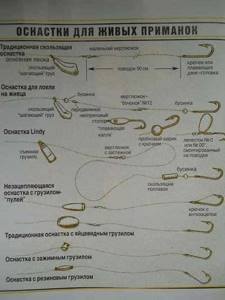
But how can you make a whole fish float to the required distance?
For these purposes, a floating element is introduced into the body of the bait. This could be a piece of foam or other highly buoyant material. The easiest way to administer it is through the mouth, after making the surface of the material smooth.
In this case, the resistance when inserted into the fish will be minimal. At the required distance from the hook (20-30 cm), you need to place a rubber stopper and a bead to slow down the sliding weight.
The line will pass through it without the slightest resistance, which is very important when catching a cautious predator.
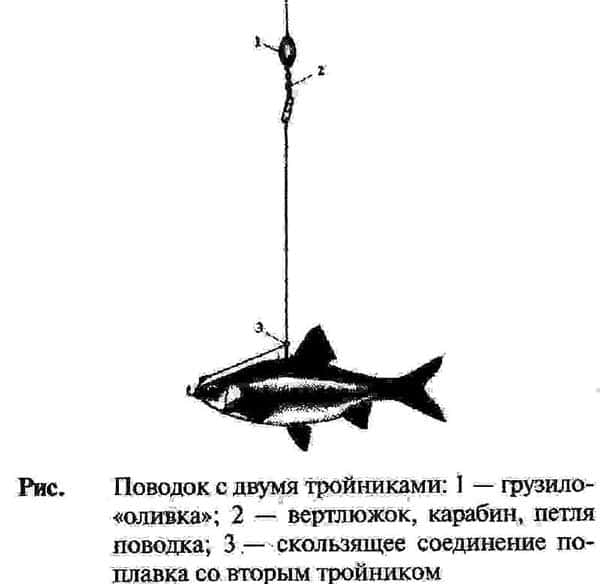
Bottom tackle for live bait from the shore (Video)
Secrets and methods of catching pike perch
Before considering the secrets of catching pike perch, it is worth spending a few words on the pike perch itself and the peculiarities of its behavior. Without this knowledge, it will be impossible to properly plan your fishing trip and choose the most appropriate fishing tactics.
First, let's look at the habitats of pike perch. We are not interested in small low-flow lakes with silted bottoms, since pike perch cannot live in such reservoirs. The ideal habitat for pike perch is a deep, mid-latitude river with moderate currents and complex bottom topography. The relatively warm waters of such rivers provide pike perch with a sufficient amount of food, and the presence of a current has a beneficial effect on the oxygen regime, to which pike perch is so sensitive.
When choosing a place for catching pike perch, special attention should be paid to exits from channel holes and areas near hydraulic structures located at great depths. In both cases, there should be at least a slight current in the selected areas. Also very promising are areas along channel dumps, deep-water “tables” with heterogeneous terrain and a rocky or clay-rocky bottom, holes below riffles and sections of the river below dams. When analyzing these theoretically promising areas, we can conclude that they are all united by three factors: depth, heterogeneous bottom structure and the presence of current. Based on this, a section of a reservoir in which all of the above components are expressed to one degree or another can be considered potentially catchable, even if it was not described above.
The only exception concerns fishing for pike perch at night. At night, pike perch often goes out to feed in shallow coastal areas of the reservoir, or at least to depths shallower than those at which it fed during daylight hours.
But the secrets of catching pike perch don’t end there. I consider it necessary to dwell on the feeding characteristics, or rather the structure of the pike perch’s mouth. The pike perch's mouth is designed in such a way that it can only swallow relatively narrow prey. Ignorance of these features can cause low fishing results when catching pike perch using live bait with a wide body (crucian carp, silver bream, etc.) or using wide spoons or wobblers.
Having learned a little about the peculiarities of the life and behavior of pike perch, you can proceed directly to considering the methods and tactics of catching this predator. The main methods of catching pike perch are spinning, trolling, side fishing and bottom fishing. Fishing with mugs was widely used in the past, but currently the number of fans of this type of fishing has decreased significantly.
Spinning fishing is the most accessible and versatile, which is why it has won the largest number of fans. Spinning allows you to fish with equal success both local promising areas near various types of obstacles and wide expanses of deep reaches. Of course, depending on the situation, spinning fishing can be done both from a boat and from the shore.
The most common artificial baits for catching pike perch using a spinning rod are various types of silicone baits and wobblers. Somewhat less commonly used are foam fish, which, although they do not have their own game, have proven themselves well on active fishing, in which the angler himself sets the game for the bait. It should be remembered that regardless of the type, baits must be narrow-bodied.
The simplest equipment for catching pike perch with a spinning rod is mounted on a jig head or on a “eared” sinker. Carolina, Texas and rigs with a side leash are somewhat more difficult to install, but with some experience they will not cause any difficulties for the angler.
It is worth noting that when specifically fishing for pike perch, steel leashes are not used. Pike-perch does not interrupt the leads like pike, so there is no need to unnecessarily coarse the tackle.
Catching pike perch by trolling, although not as widespread as spinning fishing, is becoming more and more popular every year, especially in trophy fishing. When fishing by trolling, mostly sinking wobblers are used. The peculiarity of trolling is that the distance of the bait is practically unlimited, which allows you to bring the wobbler to the working depth without losing the effective range of the bait. This becomes especially relevant when fishing at great depths, when spinning fishing for pike perch using wobblers becomes ineffective or impossible at all.
Side rods are used when fishing from a boat in areas with weak currents. During the fishing process, the boat slowly floats downstream or drifts under the influence of the wind current. In the second case, the speed of the boat can be reduced, if necessary, by using a floating anchor. Such an anchor is a small parachute immersed in water to a meter depth. The size of the anchor itself depends on the sail of the vessel and the strength of the wind.
Using an onboard fishing rod allows you to fish in the bottom layer with precise contouring of the bottom topography. This, of course, cannot but affect the success of fishing, which is also accompanied by the high sensitivity of the gear. It is only worth noting that onboard fishing rods are of little use for searching for active feeding fish and can bring guaranteed success only when fishing in a previously studied area of the reservoir. The same promising place can be fished several times, each time rising from the lowest point to the beginning of the site using oars or a motor.
When fishing with onboard fishing rods, soft silicone baits, live bait or pieces of fish can be used on jig heads. Catching pike perch with live bait or a piece of fish in this case will be preferable. Natural baits in most cases give better results than artificial ones, and the short fishing range, which is determined solely by the depth under the boat, allows you to quickly refresh the bait.
Fishing with side rods is carried out at depths of three meters or more. In muddy water, the fishing depth can be reduced somewhat, but here you will have to take into account natural light, since the shadow from the boat can alert the pike perch.
Catching pike perch on donkeys is carried out mainly in the dark, when the use of other fishing methods is difficult or impossible. At the same time, this type of fishing should not be underestimated - many anglers catch pike perch exclusively on donkeys, and quite successfully.
Catching pike perch from the shore is often complicated by the large casting distance required, but with the help of donks mounted on powerful spinning rods, this issue becomes completely solvable.
When fishing with donkeys, live bait, dead fish or pieces of fish are used. If it was not possible to prepare fresh bait, you can use frozen sprat. The only requirement is that the sprat must be frozen only once! Thawed and re-frozen fish meat becomes loose and does not stick well to the hook. In addition to this, with repeated freezing, a lot of juice is lost, and the sprat becomes less attractive to pike perch.
Catching pike perch by trolling, although not as widespread as spinning fishing, is becoming more and more popular every year, especially in trophy fishing. When fishing by trolling, mostly sinking wobblers are used. The peculiarity of trolling is that the distance of the bait is practically unlimited, which allows you to bring the wobbler to the working depth without losing the effective range of the bait. This becomes especially relevant when fishing at great depths, when spinning fishing for pike perch using wobblers becomes ineffective or impossible at all.
Catching Pike-perch with Dead Fish and Thin Tackle
Tackle for catching pike perch should be highly sensitive and create only minimal resistance when biting. Otherwise, the fish will immediately throw the bait.
To reduce resistance, it is important to use a reel with a free line release. The fanged predator does not immediately swallow the bait. Therefore, after a bite, you always need to give him the opportunity to pull a couple of meters of line from the reel.
This is followed by a sharp and strong hook. This is done in order to pierce the bony mouth of the pike perch with a hook. The fishing line for bottom fishing for pike perch should be soft and not very thick.
The only exceptions will be when fishing is carried out on the bottom with a lot of obstacles.
Description of the rig with a dead fish
All equipment for fishing with dead fish is similar to ordinary spinning equipment - rod, reel, cord, leash. The only difference is in the bait. The bait is made from a dead fish attached to a tackle.
The rig consists of a fastening - a clip for the fish, leashes with double or triple hooks and wire, with which the fish is securely attached to the rig.
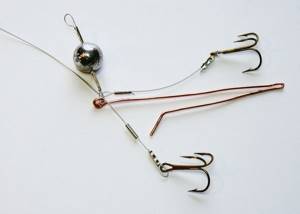
The well-known Draskovich rig for pike fishing
Sometimes a hollow cone is added to the tackle, in which the head of the bait is “hidden” so that it does not fall off the mount when passing through “strong” places - snags, grass, stones, etc.
